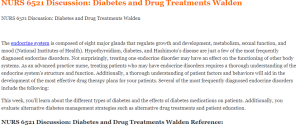Sample Answer for NURS 6521 Discussion: Diabetes and Drug Treatments Walden Included After Question
Each year, 1.5 million Americans are diagnosed with diabetes (American Diabetes Association, 2019). If left untreated, diabetic patients are at risk for several alterations, including heart disease, stroke, kidney failure, neuropathy, and blindness. There are various methods for treating diabetes, many of which include some form of drug therapy. The type of diabetes as well as the patient’s behavior factors will impact treatment recommendations.
For this Discussion, you compare types of diabetes, including drug treatments for type 1, type 2, gestational, and juvenile diabetes.
Reference: American Diabetes Association. (2019). Statistics about diabetes. Retrieved from http://diabetes.org/diabetes-basics/statistics/
RESOURCES
Be sure to review the Learning Resources before completing this activity.
Click the weekly resources link to access the resources.
WEEKLY RESOURCES
To Prepare:
- Review the Resources for this module and reflect on differences between types of diabetes, including type 1, type 2, gestational, and juvenile diabetes.
- Select one type of diabetes to focus on for this Discussion.
- Consider one type of drug used to treat the type of diabetes you selected, including proper preparation and administration of this drug. Then, reflect on dietary considerations related to treatment.
- Think about the short-term and long-term impact of the diabetes you selected on patients, including effects of drug treatments.
BY DAY 3 OF WEEK 5
Post a brief explanation of the differences between the types of diabetes, including type 1, type 2, gestational, and juvenile diabetes. Describe one type of drug used to treat the type of diabetes you selected, including proper preparation and administration of this drug. Be sure to include dietary considerations related to treatment. Then, explain the short-term and long-term impact of this type of diabetes on patients. including effects of drug treatments. Be specific and provide examples.
BY DAY 6 OF WEEK 5
Read a selection of your colleagues’ responses and respond to at least two of your colleagues on two different days who selected a different type of diabetes than you did. Provide recommendations for alternative drug treatments and patient education strategies for treatment and management.
Note: For this Discussion, you are required to complete your initial post before you will be able to view and respond to your colleagues’ postings. Begin by clicking on the Reply button to complete your initial post. Remember, once you click on Post Reply, you cannot delete or edit your own posts and you cannot post anonymously. Please check your post carefully before clicking on Post Reply!
Students will:
A Sample Answer For the Assignment: NURS 6521 Discussion: Diabetes and Drug Treatments Walden
Title: NURS 6521 Discussion: Diabetes and Drug Treatments Walden
Types of Diabetes
Diabetes is commonly thought to be related to eating too many sweets and to be managed by avoiding sweets, but since the condition
is an issue of carbohydrate metabolism it is much more involved than managing sugary food intake. Each type of diabetes has the sign of sustained hyperglycemia without treatment, but the process and treatment of Type 1, Type 2, gestational and other causes of diabetes has some variance and particular considerations for treatment (Burchum, 2017). According to the American Diabetes Association (ADA) (2019), a basic breakdown of differences are as follows:
- Type 1 diabetes is characterized by beta cell destruction in an autoimmune response resulting in the body’s ability to produce little to no insulin. (Known previously as juvenile diabetes.)
- Type 2 diabetes is characterized by a decrease in the beta cell secretion of insulin and increased resistance to insulin.
- Gestational diabetes is characterized by second and third trimester diagnosis of diabetes that was not apparent prior to pregnancy and resolves with birth.
- Other types of diabetes are due to a destructive process interfering with insulin production or processing and causing sustained hyperglycemia dependent on factors of the specific disease.
One Drug Used specific to one type of Diabetes
Gestational diabetes mellites (GDM) develops and resolves with pregnancy. According to McIntyre et al. (2019) GDM is the most common medical complication of pregnancy and increases risk factors for both mother and child for multiple long-term health conditions. While diet modification and increased physical activity are the ideal treatment for GDM, one drug used to manage the immediate pregnancy outcomes usually includes insulin (McIntyre et al., 2019).
Click here to ORDER NOW FOR AN ORIGINAL PAPER ON NURS 6521 Discussion: Diabetes and Drug Treatments Walden
Insulin does not cross the placenta, which makes it safe for the fetus while providing the glycemic control necessary for the mother, but can be concerning to the mother due to the increased burden of pregnancy related to the discomfort from needles, costs of treatment and episodes of hypoglycemia (McIntyre et al., 2019). Human insulin is given in multiple daily doses, according to blood glucose monitoring results, drawn up in a syringe and administered subcutaneously (ADA, 2019). NURS 6521 Discussion: Diabetes and Drug Treatments Walden
Dietary considerations related to treatment
Pharmacological treatment is initiated to manage GDM if hyperglycemia persists for more than one to two weeks after lifestyle interventions are initiated (McIntyre et al., 2019). Many patients are able to manage GDM with diet and exercise to avoid the necessity of pharmacological interventions and the related complications of poorly managed GDM (McIntyre et al., 2019). According to the ADA (2019) Glucose self-monitoring throughout day timed around meal with consideration to carbohydrate intake and activity is an aspect of pharmacological or diet-controlled management of GDM. Avoiding excessive weight gain is one aspect of lifestyle focused interventions.
Short term affects
The intensity of pharmacological treatment is determined by monitoring and measurement of the rate of fetal growth and is intended to prevent the short-term complications of GDM of fetal overgrowth and pregnancy complications (McIntyre et al., 2019). Complications of pregnancy reported by Johns et al. (2018) can include gestational hypertension, pre-eclampsia, polyhydramnios, Caesarean section, and shoulder dystocia creating an urgent need for diabetic management.
Long term affects
Johns et. Al (2018) reports a rate seven times higher for women that experienced GDM to develop Type 2 diabetes. Both maternal and offspring long term complications include development of Type 2 diabetes, obesity and cardiovascular disease (McIntyre et al., 2019)
Conclusion
Glycemic control is a cornerstone goal of diabetes management, but one type of diabetes may respond to a combination of treatment differently than another type of diabetes. Diabetes is a complex condition that is essential for the nurse practitioner to understand thoroughly and gain expertise in managing treatment and patient education. NURS 6521 Discussion: Diabetes and Drug Treatments Walden
References
American Diabetes Association. (2019). 2. Classification and diagnosis of diabetes: standards of medical care in diabetes—2019. Diabetes care, 42(Supplement 1), S13-S28. https://doi.org/10.2337/dc19-S002
Burchum, L.R. J. (2017). Lehne’s Pharmacotherapeutics for Advanced Practice Providers – E-Book. [MBS Direct]. Retrieved from https://mbsdirect.vitalsource.com/#/books/9780323447799/
Johns, E. C., Denison, F. C., Norman, J. E., & Reynolds, R. M. (2018). Gestational diabetes mellitus: mechanisms, treatment, and complications. Trends in Endocrinology & Metabolism, 29(11), 743-754. https://doi.org/10.1016/j.tem.2018.09.004
McIntyre, H. D., Catalano, P., Zhang, C., Desoye, G., Mathiesen, E. R., & Damm, P. (2019). Gestational diabetes mellitus (primer). Nature Reviews: Disease Primers,https://doi.org/10.1038/s41572-019-0098-8


